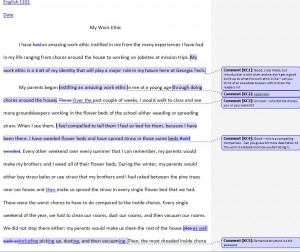At the end of the semester I like to take some time to look back at the classes I just taught and evaluate how they actually turned out. It always feels like a leap of faith to me, trusting that the syllabus I created in the quiet summer months and the carefully crafted assignments I designed to move students through learning to praxis will actually work in real life, in real time, with real students.
Looking back at my English 1101 class this semester, I feel pretty good about the way that things turned out: the students performed well across all three sections, the assignments seemed to do a good job of connecting the targeted outcomes with the content of the course, and the students rehearsed all the elements of WOVEN (Written, Oral, Visual, Electronic, Non-verbal) communication in individual and group projects (you can read about one of those projects, a “Digital Archiving” project here). But if there’s one thing that stands out as “the thing I want to work on next semester” it’s giving feedback. With my current class load – three sections of 25 students – I always feel like I don’t have time during the semester to give enough individual feedback, either on the assignment itself via comments or face-to-face with students in conferences. Ideally, I would meet with each student when I return each assignment and talk them through my comments and assessment. Realistically, I would like to optimize the way that I give students written feedback directly on the assignment (i.e. with comments on a rubric or line-notes on a paper) and also build in time for individual meetings at least twice a semester.
Written feedback on papers/assignments
Currently, I read and grade students’ papers in a word-processing document and then use the “track changes” and “comment” feature to guide the student through my experience and assessment of their papers.
The result looks something like this: 
One of the problems with this method is the overwhelming effect that a paper full of highlights and comment bubbles can have on a student. This semester I tried two things: first, I changed the default colors of my highlighting to less “harsh” colors, to make the effect less visually stressful – a paper covered in red strike-throughs does not invite a student to read the comments and process the feedback, no matter how positively it is phrased. An even better idea recommended to me by a colleague which I will implement next semester is to color-code the highlighting to fit with the category of assessment from the grading rubric: yellow for “Conventions,” green for “Stance and Support,” blue for “Organization,” etc. That way, students can immediately evaluate what kind of errors they are making and prioritize their revisions accordingly. This prioritization of feedback leads me to the second idea I implemented this semester: scaling back the number of corrections and comments and focusing on two to three main issues thus giving the students specific guidelines on what to do with this feedback and how to work on it for the next assignment.
Again, ideally I would have a course management software (CMS) that would integrate all of these steps, but, for now, I plan to keep grading online but increase my use of macros to insert comments that directly correlate with a specific assessment rubric. I use this method for papers and multimedia projects alike (although I modify my rubric for each one) but it is still incredibly time-consuming and still not as effective, I feel, as giving face-to-face feedback to the student.
Face-to-face Feedback
My preferred way to give feedback is to schedule a 10-15 minute conference with each student after every assignment to guide them through my comments and recommendations. I find I can be much more focused and much clearer in my advice to students in a situation where I can point to specifics in a paper or project and then discuss strategies for revision collaboratively with them. But, logistically, I can’t fit in three or four conferences per student per semester with 75 students – I wouldn’t have time for class! I have used the strategy of assigning work on a group project for a class session and then pulling students out of class for individual meetings, but even that spreads into two weeks of class for a Tuesday/Thursday class. One idea I’ve considered is to record my feedback as a sort of pod-cast that would be available for the student to download within their CMS (T-Square here at Georgia Tech) which would at least allow me to talk directly to the student and narrate my immediate reactions to an assignment along with my assessment. I’m not sure how I’d go about doing this, but it might serve as a balance between written-only feedback and face-to-face meetings. Another suggestion I got this semester was to give feedback to small groups and to target one or two problems that appeared class-wide during the discussion. Students can then apply the fundamentals of our discussion to the specifics of their own papers individually. I really like this idea and will definitely be trying it out next semester.
So, how do you fit in and organize face-to-face feedback during a busy semester? I’d love to hear any of your experiences/innovations with giving feedback to students – written or face-to-face. Please leave your ideas in the comments!

Pingback: TECHStyle | Blog | End of Semester Wrap-Up: Fall 2010 Edition
Pingback: Thinking about Feedback | The Arcades
Pingback: TECHStyle | Blog | The Parachut<e>: Post-assessment Peer Review?